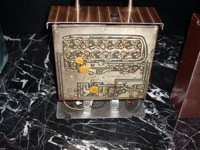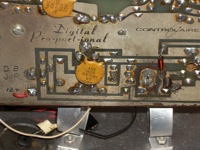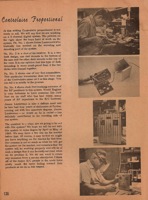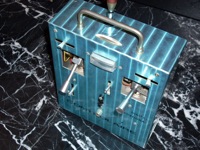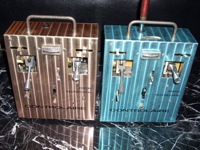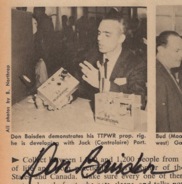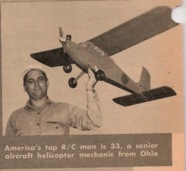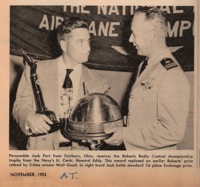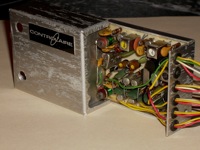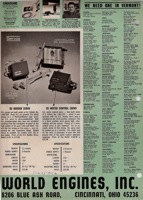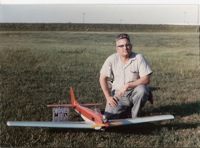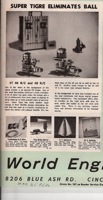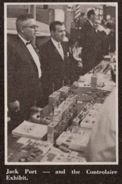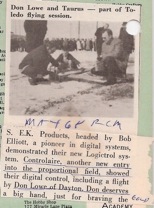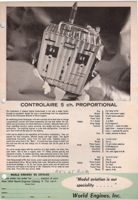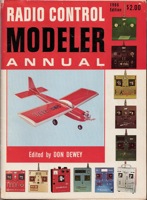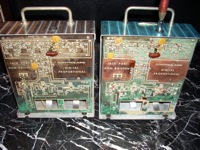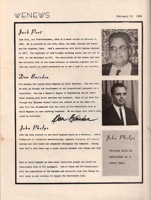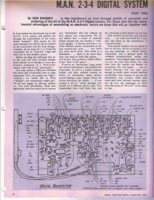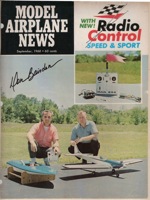Special Exhibit:
First Controlaire Proportional
An American Tragedy with a Happy Ending
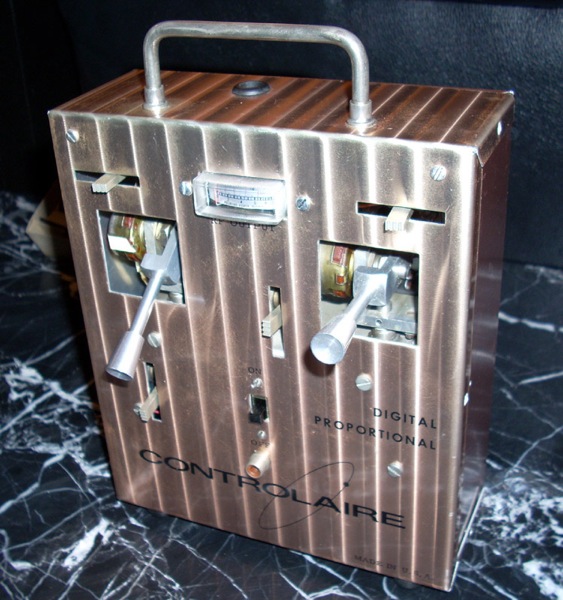
(Click on any of the images on this page to see a larger version)
This was the first Controlaire proportional. It was jointly designed by Controlaire’s legendary chief Jack Port and electronics wizard Don Baisden in mid-1964. Baisden, who lived in Columbus, Ohio then, sent Port a PC board layout for the encoder.
Port put this on the top of the circuit board and laid out a transmitter circuit on the bottom. When Port assembled it, he proudly incorporated both their initials into its circuit board along with, in a light-hearted moment, the name “Controlaire Pro-Port-ional”.Here are 2 publicity photos (1 photographically reversed, the other mislabeled) of Jack Port working on the first proportional:
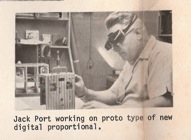 | 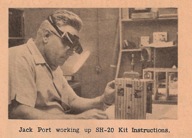 |
Initially it looked nothing like this on the outside. We believe it was housed in a modified silver Controlaire reed case and had simple Pro-Trol sticks (which may still be in the above publicity photos). After initial testing it was clear Port and Baisden had achieved a major milestone, but their promising new proportional would need some work.
Port and Baisden extensively modified and refined this system and purchased five cases to produce finished-looking pre-production prototypes and take the system to the next level. Three of these cases were the customary silver but the other two were blue and brown to test possible color variations under consideration. The cases arrived before the pre-production prototypes were done.
Evidently, when Port saw the brown case he couldn’t resist or had to meet the deadline for the above publicity photos, and promptly put his initial prototype in it despite the fact that the sleek new case was too thin for his thick original prototype. To this day the back won’t fit on all the way.
This first ever prototype was obviously very different on the inside including the unique size and layout of its P.C. Board, identifiable in the publicity pictures. But it was also different externally and mechanically. It is hard to tell from the publicity shots whether the sticks were the same as now. The gimbal“L” brackets the sticks attached to were different than later prototype and production models. The left one was smaller with a different shape, different holes and adjustment screws and a different spring centering mechanism. The trim and auxiliary levers were solid aluminum with “teeth” on the tips. These were unlike later prototypes and production models, appear identical to those on early Orbit transmitter and can be positively identified in the publicity photos with a magnifying glass.
In December of 1964, World Engines had just completed its 1965 catalog. At the last minute, they added some updates on their proportional project. All manufacturers were under great pressure to produce a proportional system or at least show progress. In order to “show something” they published pictures of the first prototype even though they were well along on the more advanced pre-production prototypes at that time. They said it was impossible to be sure when the system would be ready, but their prediction proved quite accurate. Here is their proportional status report, including a larger picture of the first prototype:
After Port took the brown case, for his initial prototype, there were four of the new cases left for constructing the final, pre-production prototypes. Baisden staked his claim to the blue case for his personal prototype (blue was his favorite color) and here’s how it looks today:
Baisden’s blue set was the second Controlaire Proportional completed, or if you prefer, the first Controlaire Proportional ever made in the refined, “final” form. It may also be the only blue Controlaire ever built. Here they are together, number one and number two/one.
The First Controlaire Proportionals.
From Toledo to Toledo
The story of this system began at the March 1964 Toledo tradeshow. It was at this show that Jack Port met Don Baisden. They were mutually impressed and quickly hatched a plan to chase the Third Dream of Radio Control and jointly develop a full-house proportional system for Controlaire. One year later at the March 1965 Toledo show, the system was unveiled.
Here is a picture of Don Baisden at the 1964 Toledo show. Note how the editor misunderstood the story and reported that the pictured single stick transmitter was the product of the Port-Baisden collaboration. Actually, this was an analog system developed entirely by Don Baisden. It was essentially a transtorized version of the Space Control. This was scrapped shortly after the show when Port and Baisden decided to shoot for a more advanced digital system.
Design Duo
Right after the 64’ Toledo show the two men went to work on the new proportional system. There was no time to waste. Proportional was recognized as the way of the future and other manufacturers seemed to be introducing new systems every month or two.
Baisden (pronounced Bays´-din) was a top engineer for North American Aviation (and other companies) who helped develop such famous full-scale aircraft as the C-5 Galaxy, the Lockheed Jetstar and the Gates Learjet. He was also an avid modeler and inventor of the “Baisden Pulser” – an early pulse proportional system kitted by Ace Radio Control. See “Baisden One”. His advanced-degree credentials neatly complimented Port’s self-taught genius. He served as consultant only, keeping his “day job” at North American. He was principally responsible for the encoder/decoder and Port for the RF section. Jim Lanterman designed the servo amplifier.
Port knew he liked Baisden and the way his engineering brilliance was wrapped in an easy-going, modest personality; what Port didn’t know was that he was training his successor who would soon struggle to fill his shoes when Port tragically passed from this world just months later.
Jack Port was “Mr. Controlaire”. He founded the company and continued to run it after its merger with World Engines. In the early 50’s Jack developed a reliable single channel system which he dubbed “Controlaire”. Some RC elites looked down on him as merely a lone midwestern tinkerer, not with a big company, who only flew home-made, single-channel equipment. Then something happened. The 1953 Nationals. Nobody ever looked down on Jack Port again.
Jack Port won the radio control competition at the 1953 Nationals and did it with his single channel Controlaire. This stunned the RC world at the time and it should have since the underdog Port beat all the other contestants even though most of them had multi-control systems. How could this happen? How could it be even scientifically possible for a rudder – only ship to beat more capable aircraft with multiple controls flown by ace pilots? Two words. Jack Port.
Here is a picture of Jack Port with his NATS-winning plane (March 54’ Air Trails):
Here is Jack Port receiving his NATS trophy (the one on the left was his alone; the globe trophy was passed forward each year to the next winner of the NATS):
And here is how that trophy looks today in our museum:
After this win, Jack went on to develop a full line of Controlaire radios—single and multi/reeds. They were known for power (e.g. the power of a mule) and reliability. The one thing Controlaire lacked was a multi-proportional system. They were a little late getting into the proportional RC race and determined to make their entry the best.
Best Sticks Ever Made
The “best” meant having a light-weight single-deck receiver with fewer parts, a transmitter with four times the power of the famous “mule” and the finest control sticks ever made. The sticks combined the pot/gimbal attachment piece with the stick itself as a single part machined out of a single block of aluminum. To save money all other manufacturers had these 2 components fabricated separately, threaded and screwed together. Here is a photo of a Controlaire machinist actually making one of these sticks:
The quality of the Controlaire proportional sticks was so high that they were actually featured, without the transmitter, in Controlaire ads. Here is an example from the June 1965 edition of Radio Control Modeler magazine (RCM):
The quality of these sticks was so high, in fact, that they had to be discontinued almost immediately due to their exorbitant cost. Soon after production began, Controlaire switched to the much less expensive Bonner sticks widely used by other manufacturers. We are uncertain how many open-gimbal models were made but our best guess now is only 15 – the 5 prototypes (one of which was featured in early ads) plus the first 10 production units. Research continues. Let us know if you are ware of any open-gimbal Controlaires in existence and we will add this to our database to clarify this part of Controlaire history.
In addition to having control sticks which were industrial works of art, the first Controlaire proportionals sported beautiful, hand-crafted trim and auxiliary levers. These had curves which visibly varied from unit to unit and little cups at the tip to accommodate fingertip (thumb-tip) control. These unique trim levers continued to be used for a while on Bonner stick production units, for the auxiliary channel.
The desire to have the best quality regardless of cost continued beyond the stick components. For example, Baisden was enamored of silicone controlled switches (SCS), enabling reliable receiver function in a compact single-deck configuration. They were employed in initial production units despite their staggering cost – over 6,200 percent higher than the standard transistors used later.
Finally, the color had to be selected. One day Don Lowe, the famous flyer, was visiting with another competition pilot, and John Maloney decided to put it to a vote. Baisden voted for blue, and Port preferred the brown/gold color which was evidently intended to hark back to the color of Controlaire’s first radios (See Controlaire Section), but also liked the blue better than the silver. However, John Maloney, Don Lowe and his flying friend all voted for the silver color and the matter was settled by this 3-2 verdict.
With the pre-production prototypes ready, everyone waited for the winter weather to clear enough for the first test flights. Finally, on December 23, 1964 Jack Port, John Maloney and Don Baisden watched as Jack flew Maloney’s silver prototype in Jack’s best plane – a Taurus. The winter wind really kicked the airplane around but in National Champion Jack Port’s hands, the loops, rolls and other maneuvers all looked great and the landing occurred without damage despite nasty gusts. The three men were jubilant! They knew that they had a winner, and took their wives out on the town for a night of celebration. Here’s a rare photo of Jack Port 6 months later with that same Taurus and transmitter (or a first production model):
Dramatic Debut
Months before the 1965 Toledo tradeshow Controlaire gave RCM a “stealth” advertisement so that, after publication lead times were factored in, it would run concurrent with the system’s planned unveiling at the show. This ad was for engines but if you look in the background you’ll see a blurred, unmentioned presence waiting its turn in the limelight. Here’s how this “teaser” ad looked (March 65 RCM):
At the show Jack Port manned the Controlaire booth. He stood behind the entire Controlaire line, literally and figuratively, including the new star attraction – the Controlaire Proportional. The proportionals displayed that day were probably prototypes.
Champion RC pilot Don Lowe gave a flight demonstration of the new system at the Toledo show. It worked so well (and his skill level was so high) that he pulled this off from a parking lot, in the snow, in winter wind conditions with a borrowed Taurus.
Years later World Engines would produce a top of the line open-gimbal contest system called the World’s Expert Series. This was heavily influenced by three consulting pilots who truly were “world’s experts” – Jim Kirkland, Dave Brown and Don Lowe. Don Lowe’s custom made “world’s expert” transmitter is now in the Radio Control Hall of Fame® museum. See World Engines.
A month or two after its unveiling at the Toledo show the Controlaire Proportional literally broke out into public view with this first real advertisement (MAY 65 RCM):
At the same time Controlaire ran this ad in American Modeler which also showed their Galloping Ghost and 3-channel systems (May/June 65’ AM)
Interestingly, the pictured 3 channel was probably just a mock-up of a then-planned system which was never actually produced or even prototyped. Years later Controlaire again considered making a 3-channel version and went so far as to produce 2 prototypes, but these never went into production. (See “Controlaire Three Channel”)
For its 1966 Annual edition, RCM included a picture of the prototype Controlaire proportional on its famous cover displaying the amazing array of systems then available in that golden era of proportional development:
In early 1965 Controlaire completed its first production run of 50 units and prepared for brisk sales. Everyone there believed they had the finest system available both inside and out. Flight testing confirmed the Controlaire Proportional performed as good as it looked. Port and Baisden were so proud of their accomplishment that they “signed” their names into the circuit boards of the initial transmitters. Here’s how these unique autographed models looked:
As the initial production units went out the door everyone turned their thoughts to the expected acclaim, massive sales and commercial success that seemed sure to come.
Fate had other ideas.
Trouble Then Tragedy
Shortly after the first sales the complaints began. Airplanes were crashing due to episodic loss of control. Pilots were angry and Controlaire’s sterling reputation for quality and reliability was tarnished. All advertising and sales were halted for over a year until the problem could be solved and the solution verified.
Then things got worse, much worse.
Jack Port had a heart attack and had to be hospitalized. Seven weeks later he had a second massive attack and did not survive. Model aviation lost one of its greats and Controlaire was thrown into disarray. Here is the tribute to Jack Port published in the March/April 1966 edition of Grid Leaks magazine:
Baisden Takes Over
When Jack Port was in the hospital after his first heart attack World Engines owner John Maloney, visited and asked Jack’s opinion. What should he do if Port had another heart attack or became incapacitated? Port’s reply: “Hire Baisden – fast.” And that’s just what Maloney did, making Don Baisden, an attractive offer to lure him from his prestigious big – company career. Don gave up his position in Atlanta working on the C-5 Galaxy and moved to Cincinnati to take over as World’s Chief Engineer and head of the Controlaire division. Here is the in-house newsletter announcing this event:
The Controlaire team turned its full attention to solving their Proportional Problem. They faced a mystery. Why did most units work fine all the time while others suffered an occasional, but fatal flaw? They all appeared identical. Eventually, by excluding pilot error and other factors they narrowed the problem to about 15 of the first production systems. Even these 15 worked well most of the time but occasionally, at certain flight distances and angles, all control was lost. When this happened with insufficient altitude to recover, the result was catastrophic. Crashed systems worked fine when returned to the factory and there appeared to be no explanation for these frightening failures.
Solving The Puzzle
Finally one of the technicians accidentally discovered the problem while viewing a monitor. By holding the transmitter at certain angles and distances the technician saw on the oscilloscope that the receiver (on its own) would direct full hard-over controls without touching the transmitter’s sticks. This happened because, on some transmitters, the oscillator signal leaked through the buffer and filled in the “off” portions of the signal.
Controlaire always prided itself on the exceptional power of its transmitters. To achieve extraordinary power output for its proportional system, a three stage RF section was devised. The first was a crystal-controlled oscillator running constantly; the second, an amplifying/impedance matching “buffer’; and the third was a power output stage.
The signal inversion discovered by the technician sometimes occurred because the digital keying (modulation) was accomplished at the transmitter’s buffer stage. By switching this function to the oscillator stage the problem vanished.
They never had a chance to celebrate this solution to their Proportional Problem because their system continued to crash planes. In fact their problem grew worse as system failure became the rule rather than the exception. Flyers would suddenly lose all control mid-flight and helplessly watch their expensive planes fly away or crash, depending on the last position of the control surfaces at the time control ceased. As the chorus of angry modelers grew louder and returned systems piled up, the very future of Controlaire was threatened. John Maloney said: "It's a good thing Jack isn't here, 'cause this would've killed him."
Eventually, the culprit was found. It wasn’t the transmitter or receiver this time, the problem was in the servos. This problem never occurred in the test flight with prototypes since they used modified Bonner servos as an interim measure. The production systems were to use a newly developed servo with linear, double-ended output and an advanced motor and amplifier.
To prepare for the expected production volume of Controlaire’s promising new proportional system, John Maloney bought 2,000 Mitsumi Motors as a great price. These little motors were excellent performers in applications up until then such as advancing film in cameras. But the duty cycle and environment of model aircraft servos were very different.
The turning point came when Don Baisden was awakened at midnight by a call from his boss. Maloney was in a lunch meeting in Japan with a lot of worried Mitsumi executives and engineers. He asked Baisden to explain how the servo motors were failing. Slowly, Baisden laid out the whole, terrible truth.
During periods of sustained activity the servo motors would heat up. This caused insulation between segments of the spinning commutator to soften and ooze out onto the conductive surface. Each portion of the commutator covered by this ooze was a “dead spot”, effectively insulated from the motor’s brushes. So long as the motor was running, the contact points would skip over these dead spots and everything was fine. There was also no problem after a servo motor stopped, provided it stopped anywhere but on a dead spot (it would start up again and perform normally).
But whenever a servo motor happened to stop on a dead spot it would not restart. This locked the aircraft into whatever control surface position it happened to be in at the time the servo stopped. All subsequent commands were as ineffective as if the transmitter had been turned off, and the plane was doomed.
By the time Baisden completed his groggy, midnight explanation, the Japanese were convinced. Mitsumi agreed to replace all the motors without charge, despite the financial blow to their company.
System Returns To Market
Controlaire let a few more months pass to allow bad memories to fade and complete vigorous testing to be sure the problems were licked. They then re-entered the market with this ad (June 66’ RCM).
The next month Model Airplane News published this review of the system (July, 66 MAN):
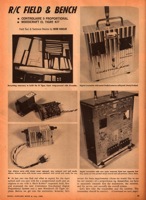 | 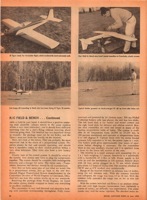 | 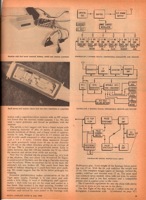 | 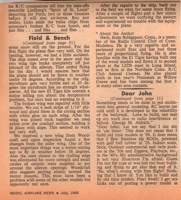 |
Note that Bonner sticks have replaced their magnificent predecessors (although the sleek Craig Asher 5th channel control is still there) and that numerous changes are evident on the circuit board.
One change stands out. The names “Jack Port” and “Don Baisden” are gone. And there is a hole in the heart of the circuit board where they once proudly stood.
Epilog
Success soon returned to Controlaire. Although sales of the reformed system were slow at first, they picked up after a third redesign replaced the Bonner sticks with O.S. models. Controlaire briefly considered introducing a budget 3 channel rig (see Controlaire Three Channel) but decided instead to do the M.A.N. 2-3-4. This was a substantially redesigned and updated Controlaire proportional offering 4 channels of control in an affordable kit format. Its introduction was teamed with a series of monthly construction articles by Don Baisden in Model Airplane News. These enabled even electronics “dummies” to build their own modern proportional system by simply following Baisden’s step-by-step recipe “like baking a cake”.
The M.A.N. 2-3-4 was an attempt to repeat the success of RCM’s D.I.Y. “Digitrio”. The Digitrio proportional kit was offered with a similar series of articles in RCM. So many sold that it was considered to be a great success for the magazine and for Digitrio kit producers like World Engines. The Digitrio phenomenon was a tough act to follow, but Controlaire managed nicely. The M.A.N. 2-3-4 was a homerun for Controlaire scoring huge sales and commercial success.
Here is a sample page from one of Don Baisden’s articles on how to build the M.A.N. 2-3-4:
Here is the cover of the September 1968 Model Airplane News showing John Maloney and Don Baisden, with Don holding the M.A.N. 2-3-4.
The Controlaire Proportional had finally secured the prominent place it deserved in the radio control landscape.
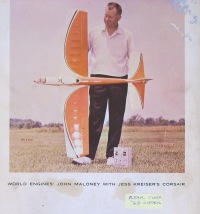 |



